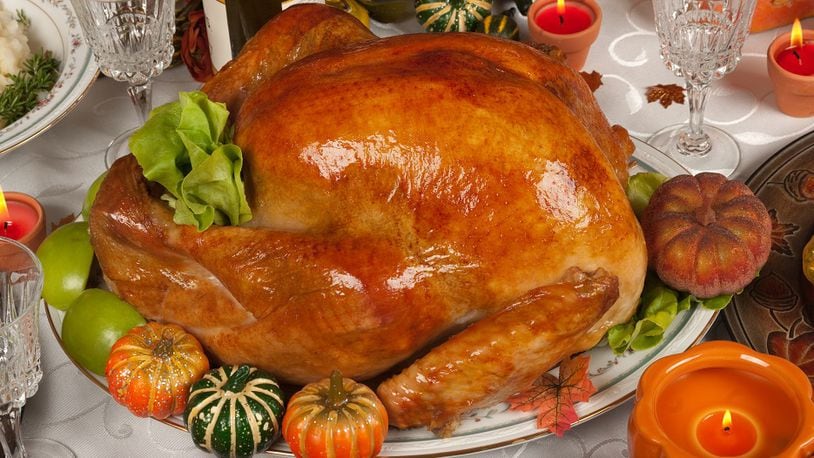Food safety, before and after dinner
• For advice on thawing and cooking a turkey, thawing a ham, and other food-prep questions, go to www.fsis.usda.gov/wps/portal/informational/askkaren.
• Never thaw the turkey on the counter.
• Wait to stuff the turkey right before it goes into the oven.
• Use different cutting boards for raw meat, poultry, seafood and vegetables.
• Keep the raw turkey away from vegetables and side dishes that won’t be cooked.
• Refrigerate leftovers promptly rather than leaving them on the table or counter for hours.
• Divide leftovers, especially large amounts of gravy and stuffing, into smaller containers so they’ll cool faster.
Tips for the perfect turkey
• Allow one pound of turkey for each person.
• Roast turkey at 325 degrees for about 15 minutes per pound, adding 30 minutes to the total time if the turkey is stuffed. Check for doneness 30 to 45 minutes prior to calculated time.
• The U.S. Department of Agriculture recommends each part of the turkey — the breast white meat and the thigh dark meat — should reach a minimum internal temperature of 165 degrees (a decade ago, their experts were recommending 180 degrees, but they changed their tune, sparing diners nationwide from the curse of dried-out white meat). Test by inserting a meat thermometer into thickest part of thigh and breast.
• Let the turkey “rest” for 20 minutes after removing it from the oven before carving.
• Looking for an offbeat stuffing recipe? Combine 10 White Castle hamburgers (no pickles) torn into pieces in a large mixing bowl with 1½ cups diced celery, 1½ teaspoons dried sage, 1¼ teaspoons ground thyme, and 3/4 teaspoon coarsely ground black pepper. Add ¼ cup chicken broth. Stuff cavity of turkey just before roasting. Recipe makes about 9 cups, enough for a 10- to-12-pound turkey.
How to carve a turkey
- Remove the legs at their joint with a sharp knife; separate the drumsticks from the thighs.
- Slice the thigh into strips parallel to the bone; slice the drumsticks while holding it upright vertically.
- Remove the wings at the joint.
- Make a long, horizontal cut at the bottom of the breast to allow the meat to fall away easily when sliced.
- Cut the breast into slices using a downward stroke.
Perfect mashed potatoes
A classic Bon Appetit recipe produces light, buttery mashed potatoes: Place two pounds Yukon Gold or russet potatoes, unpeeled, in large saucepan; cover with cold water, bring to boil, reduce heat to medium, simmer until tender (about 20 minutes). Drain well and cool slightly, then peel and mash potatoes (leaving peels on while boiling reduces the amount of water the potatoes absorb). Place mashed potatoes in large saucepan and cook over medium heat for two minutes, stirring occasionally. Meanwhile, heat ½ cup milk in small saucepan until warm. Stir ½ stick (¼ cup) of butter into potatoes. Add warm milk and stir until milk is completely absorbed. Season with salt. Serves 6.
If you’re watching your calories
• Roast the turkey on a rack so that the meat doesn’t reabsorb the fat-filled drippings.
• Bake the stuffing in a separate dish rather than inside the bird, where it absorbs fat.
• Skim fat from the top of turkey drippings before making gravy, or use a fat separator.
• Skip the butter when you mash the potatoes, substituting skim milk or broth instead.
• In desserts, use skim milk in place of whole and substitute two egg whites for one whole egg.
What wines to serve
Keep it simple, and serve pleasant, crowd-pleasing wines with a bit of sweetness, such as Rieslings, gamays and pinot noirs.
Help hotlines
- The USDA meat and poultry hot line: (888) 674-6854
- Butterball Turkey Talk Line: (800) 288-8372
About the Author
